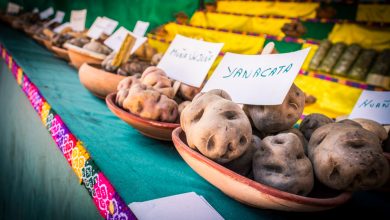Limo Restaurant: Starlight and Fine Cuisine

Like sequins on black velvet, the lights of the night surround Cuzco’s main square. From the balcony window in Limo Restaurant, on the second story of a centuries old building, the blinking lights of the square slowly grow smaller until they merge with the velvet of the sky’s ocean.
Limo celebrates the ocean and the culinary art that makes stars of the food drawn from it. It makes sense it too would be a star. Since it opened, Limo with its careful design and well thought out appointments, has come to be considered one of the best, if not the best, restaurant in Cuzco.
Most nights, the few tables on the balcony fill quickly with well-heeled tourists from around the world as later arrivals move further into the restaurant’s depths. There, a different experience of large black and white photographs of historical figures contrast the night with colors more appropriate to the depths, as if coral had aged.
Chef Coque Ossio opened Limo last year at a critical time, when the city’s suffering from the closure of Machu Picchu after an unusually heavy rainy season was coming to an end. Located in a colonial mansion on the Cuzco’s Plaza de Armas with its own history, Limo was a welcome addition and quickly became considered one of the finest restaurants in Cuzco. It was part of a galaxy of new restaurants opened by Peru’s capital Lima’s stellar chefs.
While part of the success of Limo can be laid at the feet of Ossio, who has quickly moved to the forefront of Peru´s ranks of celebrity chefs, Ossio is not the sole reason. After all, he has other excellent restaurants in Cuzco, such as the outstanding MAP–one of the main competitors for best status with Limo, and others such as Inka Grill–also on the Plaza, Incanto, Pachapapa, and Greens.

Limo’s reputation and evaluation stems from the overall quality of its offerings, the training and quality of its staff, and the outstanding design and decoration of the restaurant, including its view which merges the restaurant with the city’s lights and the stars in its night sky. To eat there, especially on one of the highly desired tables on the glass-enclosed balcony, is to have a delightful experience.
Three things build Limo’s offering. It’s name is a reference to a culinary symbol of Peru — a firey pepper of the chinense species that is often paired with fish in ceviche — and, as a result, Limo offers a particular take by Ossio on the canon of Creole dishes through a Novo-Andean lens. But, as the suggestion of the hot pepper argues, ceviche and its relatives are the restaurant’s strength. Finally, Limo’s has an extensive and beautiful bar which promotes variations on the canonical pisco sour.
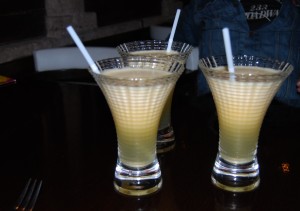
One of the Peruvian products granted a Denomination of Origin, Pisco is on its way to becoming the Peruvian drink par excellence, especially when paired with lime juice and bitters in a pisco sour. This is so much the case that, like many classic, enterprising artists, Ossio performs improvisatory riffs on it such as the maracuyá (passion fruit) sour his waiters recommend at the tables in Limo (and which Ossio served at the Organization of American States gala where he was honored as the invited chef and Peruvian cuisine was given the “Cultural Heritage of the Americas” award.)
A magnificent pairing of tart and sweet with the under rush of pisco, similar to that of the pisco sour itself, the passion fruit sour is a delight. But it is simply one of the offerings of a fine and well stocked bar with quality wine and a professional range of drinks for its clients.
Passion fruit is native to South America and some argue that before the Spanish arrived, bringing with them citrus fruit such as limes, ceviche was made with the tart juice from this well named fruit of beautiful flower–speckled like the stars in Cuzco’s sky– and amazing taste.
With this theme, and the chopped limo peppers served as a gratis appetizer along with double cooked french fries, a garlic cream, and a wakatay sauce that was the jewell that made the fries sparkle, Limo reminds us it intends to build from Peruvian roots to create high cuisine. Most of the time it succeeds.
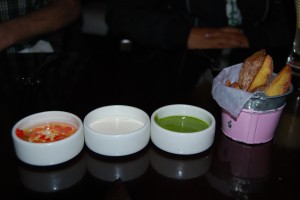
While the diced limo peppers had been made so mild, by pre-boiling, that they lost their distinctive flavor and zing, the wakatay had just the right amount of earthy, herby, minty glory that is the peculiarity of this condiment that goes back in Peru to well before the Inca empire and is found on tables throughout the country, though almost unknown outside Peru. This herb needs to be better known by cooks around the world.
Limo builds on this to make an engaging set of offerings with its classic ceviche. Called on its menu, “the five elements,” this is the basic ceviche whose recipe Ossio has been spreading widely online. The menu expands this by adding other seafood to the ceviche, and a tropical version with mango, papaya, and coconut milk, as well bringing in the other tradition of Peru, its Asian heritage with tuna, snow peas, and bean sprouts.
Not only does Peru have a large and historic Chinese community with its own contributions to Perú’s culinary tradition, it has an important and successful Japanese community which connects the country closely with the north Asian archipelago. But that is not new. There is evidence Japanese sailors may have arrived on the Pacific coast of South America some five thousand years ago, although that is disputed by the mainstream of contemporary archeology.
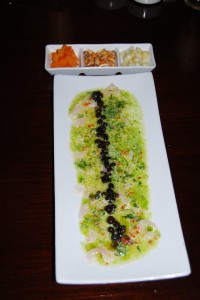
Ossio added sushi to his menu, to pick up both this Japanese Peruvian theme and the international popularity of sushi. Not only does he offer a popular international classic such as California rolls (apologies to Japan), he also offers Andean riffs on sushi by building from two classical, Peruvian sea food dishes: ceviche and escabeche.
But, the heart of this sea food constellation may well be the tiradito, a dish Japanese Peruvians developed based on sashimi. Ossio is not content to stay in Novo-Andean cooking but ventures like a sailor on a night sail on the wide Pacific in the midst of a regatta into Fusion cuisine, the blending of novo Andean with other internationally recognized cuisines, such as those of Asia, following the Peruvian tradition of borrowing and hybridizing.
The second time we went to Limo, we tried the Tiradito Andino (the first we opted for ceviche and its was delicious and well presented), an inspired blending of raw fish with lime juice, corn chicha, and wakatay. Oh my. The only fault was that it disappeared so quickly.
While all of these are considered appetizers on the menu, they are well conceived and tasty. The main courses listed stem from classic Peruvian Creole cuisine, such as pork loin, ají de gallina (a shredded chicken in a spicy cream sauce), lomo saltado, breaded fried fish (chicharrón de pescado), seco, and others.
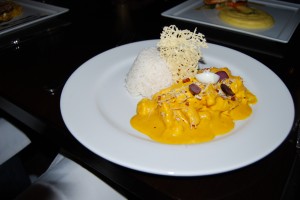
Ossio has re-imagined these classic creations to give them his own touch. For example, the ají de gallina did not come shredded, as the norm would have had it, but as a dice of chicken breast smothered in the yellow sauce. If only the sauce had been more inspired. It was unfortunately plain and lacking in the power that the dish normally has.
Similarly, Ossio redesigned the accompaniments on many of the dishes. The seco, instead of coming with rice and beans, arrives with yuca quenelles and a citrus limo-pepper honey. In this vein the pork tenderloin arrived with a black quinoa ragout. Despite the name suggesting something carefully stewed, the quinoa was a rather tasteless and over cooked lump, though the pork it accompanied was outstanding.
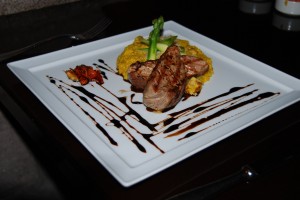
Though very well presented, the dishes were not equally well prepared. Ossio needs to work to bring everything up to the same level of quality through the attention to detail that his restaurant shows.
Though a very good restaurant, Limo’s does not quite rise to the level of its hopes nor to the quality of training and celebrity of Coque Ossio, although dining there is a good experience.
There is nothing like sitting over tasty food, a glass of fine wine in ones hand, while looking out at the pointillesque plaza of Cusco where it merges with the constellations of the night.

But before walking off into that night, it is worth stopping to chat with the white bearded gentleman who may have shown you the menu and invited you to climb the stairs to Limo. If not, he certainly will when next you visit.
Some people call him “Chito” and others “Hawaiiano,” but behind all the nicknames he is Oscar. He is the dean of Cusco’s barkers and is very well skilled at his profession. Able to communicate in a variety of languages–English, French, Italian, and Chinese — Oscar melds, charm and sophistication with a down-to-earthness that has justifiably earned him the respect of his peers and his guests. He is very popular among the Cuzqueños who frequent the Plaza de Armas, as well as tourists. He could keep you entertained with many a tale, but he will probably break the story he is delighting you with, to continue with his task, encouraging people to give Limo a try.
Every evening he takes his post by arches of the Portal de Carnes, dressed in a black hat, a dressy black jacket, well-shined shoes, and a shiny, silver chain on his chest. Chito knows how to keep guests coming into Limo, perhaps more than the reviews the waiters invariably ask guests to write online. He is a star.
And, along with Chito, we too recommend you visit Limo and enjoy a maracuyá sour while looking into the night.



